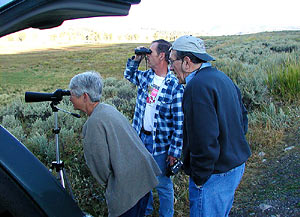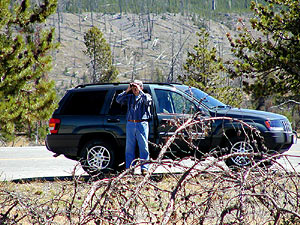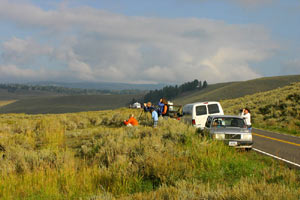|
All photos by
Tim Springer
and
Christine Baleshta
|
|

Chat
The three Yellowstone Chat pages on the internet can be another great source of information.
Yellowstone Net
Yellowstone Loon Chat
Total Yellowstone Chat
 People posting on the chats have often just returned from the Park and have trip reports or describe their experiences.
Post a message telling them when you will be there and ask for suggestions and they will be glad to help.
There are some very knowledgeable folks out there.
People posting on the chats have often just returned from the Park and have trip reports or describe their experiences.
Post a message telling them when you will be there and ask for suggestions and they will be glad to help.
There are some very knowledgeable folks out there.
Turnouts
Look for people at the turnouts, especially those with spotting scopes.
If everyone is looking in different directions then they are just trying to find animals,
but if all the scopes are aimed in the same direction and everyone is intent, then they
probably see something. Don't just sit in your car and try to see what they see as it may
be difficult to spot and it's easy to miss a great sighting. Ask to get a fix on the
location through one of the scopes and they will usually be glad to help.
NPS
Bear reports for the Park Service are also posted on the Net which can be helpful.
Park Service Bear Reports
You can often see a pattern there like grizzlies at Antelope Creek around 7:00 in the morning for the past 3 days or something.
These aren't all the bear sightings, but the sightings the park service deals with.

Dead Stuff
Another valuable piece of information is if there are any carcasses presently.
A nice dead bison can attract scavengers for at least a week if not longer.
If you manage to locate a carcass, keep checking back to see what has been seen feeding on it.
It usually takes a little while for the bears and wolves to find it (unless the wolves killed
it in the first place of course). Show up at dawn to see what the night brought out, keeping
a safe distance, of course. There will often be a number of other people checking on it - another
opportunity to get the latest news on recent predatory visitors.
Scopes/Optics
If you are deciding what optics to bring to Yellowstone, the price of binoculars
and spotting scopes becomes a primary factor in the selection process. These suckers are expensive.
Things get pricey quickly and you have to ask yourself what its value is to you. Will you be using
this item a lot or is it a one time event. If you plan on just visiting the Park occasionally and
hiking a lot then binoculars are the way to go. Small and portable they are great for spotting
wildlife and watching them as long as they are not too far away. 10 power (the first number in
the rating such as 10x30) is about minimum
 for Yellowstone. I recommend full size units, but purchase what is practical for you.
More is better, but the longer the reach the harder it is to hold steady.
One new innovation is the Canon IS (image stabilization) binoculars which by
pushing a button almost eliminate shaking and allow you to see great distances clearly.
You pay dearly for this and need to supply batteries.
for Yellowstone. I recommend full size units, but purchase what is practical for you.
More is better, but the longer the reach the harder it is to hold steady.
One new innovation is the Canon IS (image stabilization) binoculars which by
pushing a button almost eliminate shaking and allow you to see great distances clearly.
You pay dearly for this and need to supply batteries.
For bear and wolf viewing a spotting scope is a big help. 20-60 variable power is great.
Most of the time you will be using the 20 power. A sturdy tripod helps as well.
Of course, all this is very expensive and a big mess to travel with so I just
shove the tripod in a duffle bag with coats and wrap the scope in a sweatshirt
and bury it in my suitcase. The bigger the lens the more light it will let
in which is very helpful in low light when wildlife is out. Also the larger
the field of view, the easier it is to spot animals. Birding websites are
a big help in evaluating optics and the Internet is full of information.
Bears
So, you want to see a bear. Good idea. Me too.
BlackBears
Black bears can be seen almost anywhere in the park. Keep your eyes open for dark blobs at the
edge of forested meadows that are too black to be rocks or wood and seem to be moving.
The best location is the Petrified Tree to Tower Fall area in the northern part of the
park and the Blacktail Deer Plateau dirt road (when it's open). Spring is excellent,
but anytime outside of denning season November-April is worth a try. Drive
very slowly please from Roosevelt to Tower due to the number of black bears and cubs in that area.
Grizzly Bears
Grizzlies are a bit different. For the big bear your best bet is a carcass.
Otherwise, try to find a big expansive high meadow where you can glass a long distance.
Hayden Valley, Lamar Valley, Mt. Washburn and the Lake area are all good choices.
I hope that you get to see what you want, but, remember, it's always hit and miss with wildlife.
I can't tell you how many times I've come up to a spot and had people tell me I just missed it.
Happens to us all. Perseverance is the key and I wish you the best of luck.
Author - Tim Springer
Photography - Tim Springer
 |
Click for larger image
|
|

